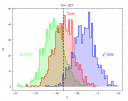The High Energy Astrophysics Division of the American Astronomical Society will meet at Los Angeles on March 31 – April 3, and we have been allocated a slot for an AstroStatistics session. It will be a 60-minute lunch-time session, so we anticipate that the session will be dominated by poster haikus and panel discussions similar to the workshop we held during the New Orleans meeting in 2004.
The meeting website is at: http://www.confcon.com/head2008/.The abstract submission deadline is January 25, 2008 (now past, but late abstracts are not unheard of among astronomers).
If you are attending the meeting, and plan to present posters or talks that deal with astrostatistical methods or techniques, we welcome you to participate in this session. When you submit an abstract, be sure to indicate a category of “Other” and in the comments field state that it belongs with the AstroStatistics special session.If you have questions, please contact Aneta or me. There is also a page for this session on the astrostat google groups site.
Update (1/22): The abstract submission page currently says that only one abstract is allowed per person. We have been informed that this is incorrect, and that people can submit two abstracts, one for the special session and one as a regular contribution. Note that posters will be up only one day, and those associated with a special session will be put up the day of the session.
Update (1/26): A detailed program is not yet available, but here is a description of the session:
Astrostatistics: Methods and Techniques
This session will provide a forum for the discussion and presentation of statistical challenges in high energy astrophysics, highlighting the great deal of progress that has been made in methods and techniques over the past decade. The one hour session will cover the current and future directions in Astrostatistics, and will include a discussion of MCMC methods in the context of specific applications (such as propagating calibration errors, defining the significance of image features, etc.); a discussion of standardized methods for computing detection limits, upper limits, and confidence intervals for weak sources; and hypothesis testing and its limitations (including the significance testing of emission lines).
Update (2/19): We have been allocated the mid-day slot of March 31. The session will run from 12:30pm till 1:30pm2pm. The tentative program is as follows:
- Remarks on current and future trends in AstroStatistics, by Eric Feigelson
- Poster haiku
- F-Test theory and usage, by David van Dyk
- Discussion on MCMC techniques, led by Andy Ptak
Update (2/26): The final program is out, and the AstroStat session is scheduled for 12:30pm-2pm at the Museum/Bunker Hill Room.
Update (4/1): The talks and posters associated with the AstroStat special session are now online at
http://hea-www.harvard.edu/AstroStat/HEAD2008/. Additional comments and descriptions will be archived there.
